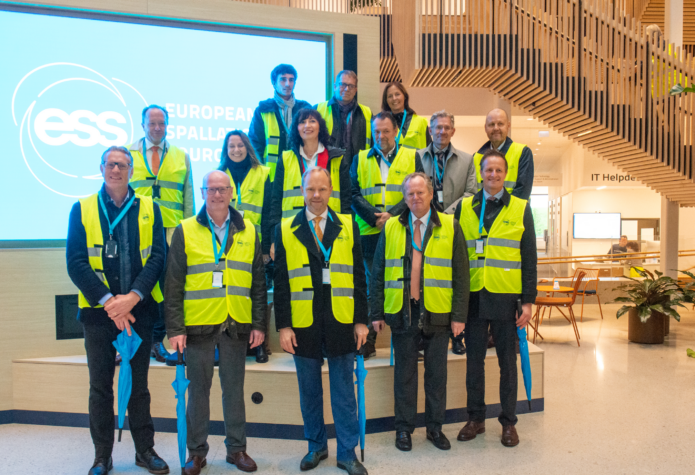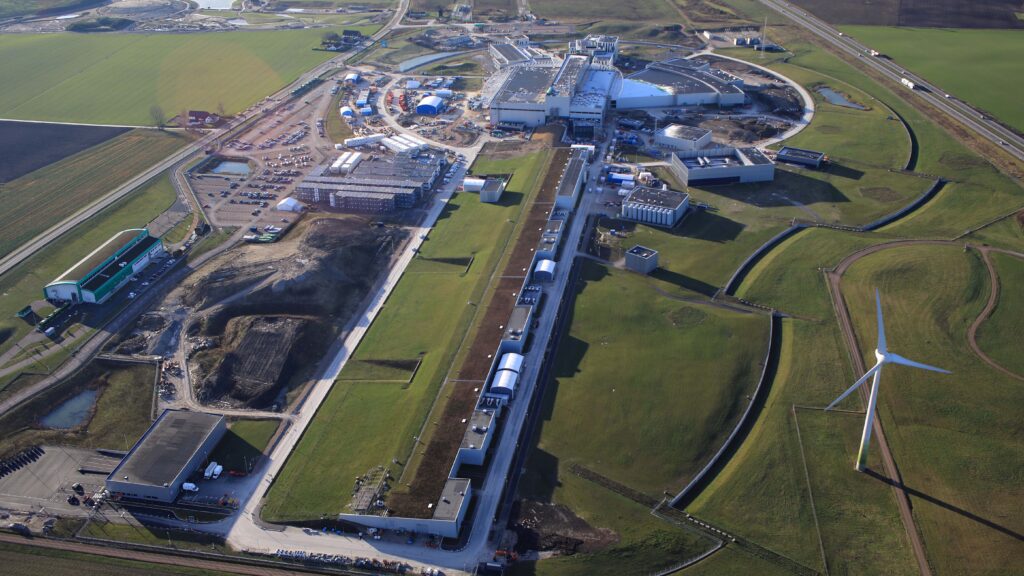European Spallation Source: A glimpse into the future

The weather forecast of heavy rain and wind proved right as we arrived on 21 October at the European Spallation Source’s (ESS’s) neutron source in Lund, Sweden. Ahead of us is a tour around the research infrastructure under construction. From the air, the facility resembles a 700-meter-long sci-fi movie spacecraft landed in an agricultural field. The science is here, but not the fiction. The neutron source will make images of how materials are built up on an atomic level, providing completely new knowledge about our world and how it works.
The ESS is a multi-disciplinary scientific research facility owned by 13 European countries. In addition to the facility in Lund, an ESS Data Management and Software Centre is in Copenhagen, Denmark. The construction started in 2014 and the first research is expected to start in 2023, with full and steady state operations commencing in 2025.
Under light blue umbrellas, courtesy of ESS, we start our walk around the facility with helmets and in steel-toe boots to face the rain in between buildings, tunnels and enormous halls packed with state-of the art technical equipment produced and delivered from around Europe. The group is made up of people from the bridge financiers of the research facility the Nordic Investment Bank (NIB), together with the European Investment Bank (EIB) and the Swedish Export Credit Corp.
As we walk, the enthusiastic people of ESS speak about how researchers will be using spallation, a process in which a proton is beamed towards a spinning Tungsten wheel, releasing neutrons that go through material under testing to produce “images” of its atom structures.
The research can be done even for processes, such as a chemical reaction or a battery delivering power, to see how atoms interact and behave. This will help to improve and develop new materials with applications in manufacturing, pharmaceutical drugs, aerospace, engines, plastics, energy, telecommunications, transportation, information technology and biotechnology.
“Once fully ready the neutron facility here in Lund will be the world’s most intensive. It will be larger than any existing one by a factor of five. It is built in partnership with scientists from all over the world and will facilitate fundamental research at the atomic level of materials to further improve them,” says Kevin Jones, Acting Director of the ESS ERIC (European Research Infrastructure Consortium).

“The potential is huge and likely to push the scientific frontiers in diverse fields, such as for instance zero-loss electric conductors eliminating a 30% loss of electricity, drugs that can attach to the right receptors in a body,” says Jones.
In parallel to the scientific infrastructure, a laboratory and office complex, the ESS Campus, was completed earlier this year. In June, the ESS Office building was environmentally certified as “Outstanding” under the international sustainability assessment method BREEAM, with one of the highest scores worldwide (91.5%).
The estimate is for about 3,000 scientific researchers to work on approximately 800 experiments for academia and industries annually. The research data is sent to the Data Management and Software Centre in Copenhagen for further analyses. One year after a research project is completed, the results will be made publicly available.
NIB President and CEO André Küüsvek says he finds the ESS a fascinating state-of-the-art research facility that is likely to be the most advanced in its field.
“The beauty of this is that so many different countries got together, from Spain in the South to Estonia in the North, to cooperate on this,” says Küüsvek.
Long-term financing
ESS will eventually be fully financed by contributions from its member states. For the steady state operations, the national yearly contributions will be based on the usage of the research facility.
The current financing from NIB, the EIB and SEK originates from the fact that the costs are front heavy. The contributions are also due to the various national budgetary processes. The financing need can therefore be described as bridge financing, which suits lenders with a political agenda.
Previously, NIB signed a seven-year EUR 100 million bridge loan for the construction phase and a 23-years loan of EUR 30 million for the construction of the ESS Campus through a loan to SKR Spallation AB. In May 2021, NIB and the European Spallation Source ERIC signed an eight-year loan agreement of EUR 50 million for the initial operation of the neutron research facility.
MAX IV
As the weather is clearing up, we walk over to the neighbouring MAX IV synchrotron light laboratory a few hundred meters away. Together with the ESS facility, they will form one of the largest science hubs in Europe, equal in size and relevance to CERN and ESO.
The lab uses the most brilliant X-ray light ever generated to study atoms and molecules only a tenth of a nanometre. It offers scientists of various disciplines access to high-intensity X-rays for material, climate, and medical research. The research at MAX IV and the ESS can therefore complement each other.
The MAX IV facility is utilised by up to 5,000 researchers annually and has the opportunity for industrial applications, thus strongly contributing to the cooperation and knowledge management at a multidisciplinary level within the region.
In 2015, NIB signed a 24-years loan agreement of SEK 1.5 billion (EUR 161 million) with the special-purpose venture Fastighets AB ML 4 for the construction of the MAX IV synchrotron light laboratory facility also in Lund.
The building was completed in 2015—also certified as Outstanding in accordance with the international BREEAM requirements—and scientific operations started the following year.
As the sun clears through the clouds, we leave our visitor tags and head out with a new perspective on how fast science can progress our understanding of the building blocks of nature. Could this be the start of something new?

